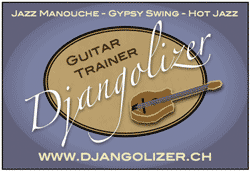
9 - Arpeggios - The basis of Gypsy Jazz
Arpeggios are chords, played in a horizontal way. Especially in Gypsy Jazz, where the rhythm guitar is played very
percussive, you can do the audience a favour, when you bring out the harmony of the song by playing mainly the chord notes.You will master your improvisations, when you can recite the chords of each song by heart.
We will start with the basic arpeggios, the triads, from "Minor Swing" and will then add some flavour with extension-notes like m6 and 7(b9).
This exercise should be done also with other chords like all major and dominant chords.
That's a lot of work to do, I know, but a must for every serious Jazz musician!
Am Arpeggio
First of all, you should learn the triads. They are the simplest form of chords and have just the three basic chord notes: root, third and fifth.Major chords have the intervals 1 - 3 - 5 and minor chords have the intervals 1 - b3 - 5.
Use triads as the cornerstones on the fretboard. They will give you a good orientation.
Be sure, that you play the down and up strokes correctly. Refer to the chapter "gypsy picking"
Guitar players:
Memorize the root notes on the fretboard. That makes it easier to transpose the arpeggio patterns (moving over the fretboard).
Select the song "Minor Swing - exercises" and make a loop over the bars 1 - 16
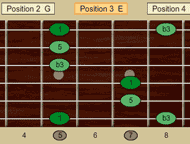

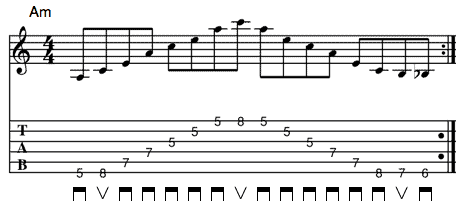
1 - Start the arpeggio on the first beat (as notated).
2 - How does it sound, when you start on the 4+ ?
3 - Play swing feel (eights)
4 - Play straight (eights)
5 - Play the arpeggio in triplets
Use these five principles for the next exercises as well.
2 - How does it sound, when you start on the 4+ ?
3 - Play swing feel (eights)
4 - Play straight (eights)
5 - Play the arpeggio in triplets
Use these five principles for the next exercises as well.
Am arpeggio diagonal
The following example is the diagonal variation of the Am arpeggio.The noted example goes a different way down than up.
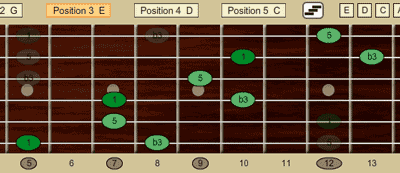
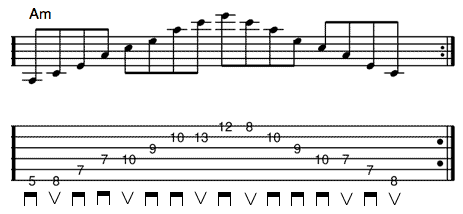
The Arpeggios Dm, E7 and E major
After mastering the two examples in Am, we do the same exercises with the other chords used in "Minor Swing": Dm and E7. Because E7 is not a triad, we leave the b7 out and do the exercise with the E major chord.
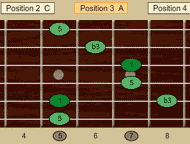
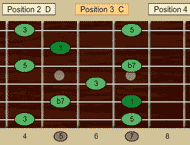
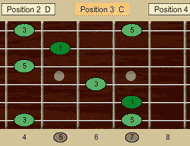









Minor Swing exercise with the basic arpeggios
The next step will be, to play the entire song with arpeggios. Start with this exercise only, when you are familiar with the last three chords Am, Dm and E(7).
The dominant chord E7 will be played as a triad, like in the example before.
Click the image, to scale up
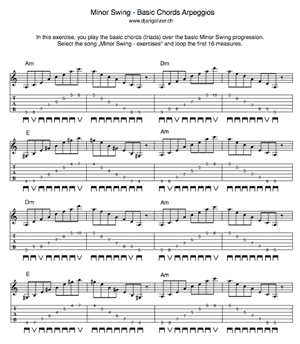
Am6 arpeggio
Make a loop in "Minor Swing - exercises" over the bars 17 - 32.In Gypsy Swing, the sixth is a very welcomed guest, to add a mystic sound to chords and arpeggios.
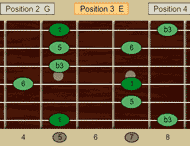

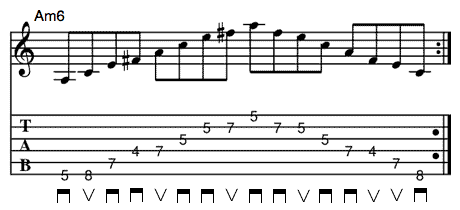
Am6 arpeggio diagonal
Here the diagonal version of the Am6 arpeggio.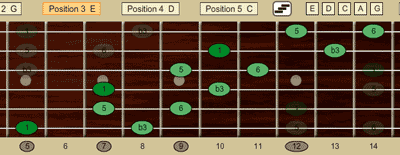
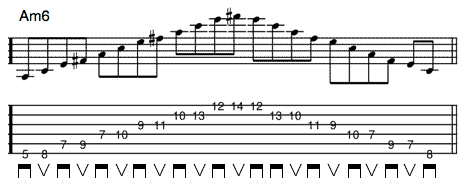
The arpeggios Dm6, E7 and E7b9
The two exercises you did with the Am before, should
be done with the other chords from the standard "Minor Swing" version
as well.
They are: Dm6, E7 and E7b9.
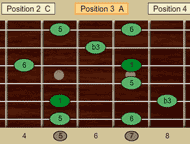

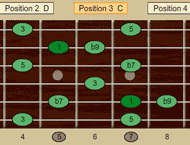



They are: Dm6, E7 and E7b9.






Minor Swing exercise with m6 and 7b9 arpeggios
In this exercise, the first four arpeggios are played up and down and the last four chords are played down and up. At the end, there is a short variation.Mind, that this exercise still is based on eights. There are no rhythmic variations.
Click the image, to scale up
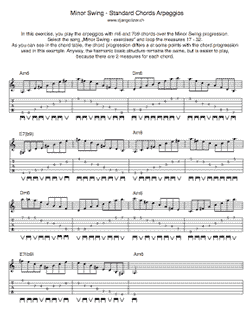
Djangolizer Power-User:
The same exercises work perfectly fine with other simple songs…in G minor
- "Minor Blues" or
- "Bei mir bist du schen"
or in D minor over the songs
- "Bossa Dorado" and
- "Dark Eyes".
All you need to do is to transpose the arpeggios to the appropriate tonalities.
Guitar players can just move the patterns to the accordingly fret (rootnote), which is pretty cool!
1. Practice arpeggios in all positions and tonalities (5 x 12).
2. Practice at least two diagonal arpeggios, which feel good in your fingers.
3. Play all chords of your favourite song in arpeggios.
Conclusion:
As a Jazz freak, you should know, how to play all the arpeggios easily over each Jazz standard! Angelo Debarre is a great example, how fast and fluently it could be done.



